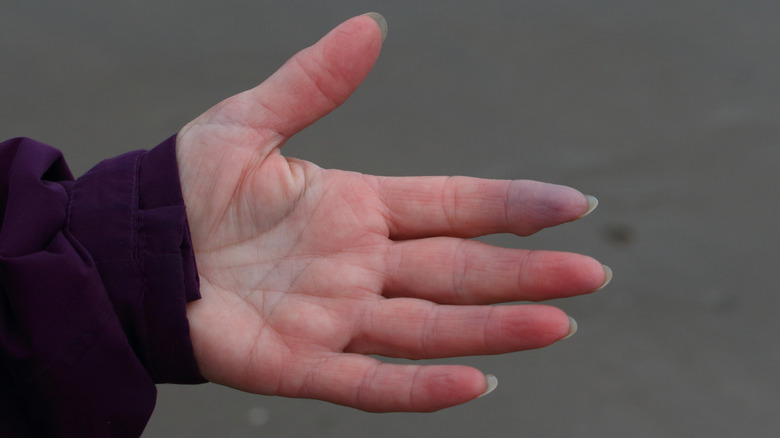What It Really Means When Your Fingers Turn Purple
It can be pretty alarming to notice your fingers turning purple, especially if it's never happened before, but what does it mean? The purple color could mean that the oxygen is being cut off somewhere, and your blood isn't circulating to the affected fingers. Your skin will change color if blood isn't circulating, and it's how your body lets you know something isn't right (via Healthline).
The U.S. National Library of Medicine notes that the cause could also be due to a variety of underlying health conditions, from frostbite to the Raynaud phenomenon. Therefore, you should see a doctor to determine the cause of your fingers turning purple. Your doctor will likely ask a few questions regarding whether your fingers turned color suddenly or if it has happened over time, before smoking, or if you have any other symptoms.
But what could be the actual cause behind the change in color, and what does it mean?
Causes of purple fingers
One possible cause is peripheral cyanosis, which is when your fingers or feet turn blue from a lack of oxygen (via Medical News Today). That blueish tint could be mistaken for purple. Symptoms of peripheral cyanosis are the affected area feeling cold and color returning to normal after warming up.
Causes of peripheral cyanosis are anything from Raynaud's disease to hypovolemic shock. Raynaud's disease is when your blood vessels narrow when you're in cold weather and blood cannot get to your fingertips or toes. As a result, your fingers and toes will change color, and it can hurt. According to Verywell Health, it can also be caused by stress.
Factors that can worsen Raynaud's syndrome are smoking, not staying warm, and rapidly changing temperatures. Keep your hands and feet warm in cold temperatures by wearing socks and gloves. See your doctor to determine if you have an underlying health condition, such as Raynaud's disease. They can help you find out why your fingers turn purple.
What to do in cases of poor circulation
If you're unsure as to whether or not your purple fingers can be attributed to poor circulation, here are some symptoms to be on the lookout for. According to experts at the Cleveland Clinic, those with poor circulation may experience feelings of pins and needles on the skin, cold in the fingers or toes, swelling, numbness, or skin that appears blue or white in color. Oftentimes, poor circulation occurs due to the narrowing of blood vessels, plaque accumulation, or blood clots standing in the way of blood flow.
Certain lifestyle factors, such as regular physical activity, maintaining a healthy diet, managing stress, and refraining from smoking, can help boost blood flow. Supplements, such as capsaicin, beetroot powder, omega-3 fatty acids, garlic, or curcumin, amongst others, may also purportedly help relieve symptoms of poor circulation (via Medical News Today).
In some cases, however, medical treatment may be required. As per the Cleveland Clinic, various medications, such as blood thinners or blood pressure medicines, may be prescribed to support circulatory health. Otherwise, surgical means may be used in removing a blood clot or varicose veins, to open up obstructed arteries, or reroute blood flow around the blockage.
Other conditions that could cause purple fingers
Aside from cyanosis and Raynaud's disease, there are some other conditions that can prompt purple discoloration in the fingers. One such condition is Achenbach syndrome, according to 2021 research published in the Journal of Vascular Surgery Cases, Innovations and Techniques. Although rare, this vascular syndrome is characterized by ongoing, painful swelling in the fingers that appears purple in color. Often seen in women between the ages of 40 and 60, symptoms can come on in waves and usually subsides within four days' time.
Vasospasms can also cause our fingers to take on a purple hue, according to experts at Cedars Sinai. The condition occurs as a result of blood vessel contractions that constrict the arteries and subsequently hinder blood flow. Also related to blood vessel function, vascular thoracic outlet syndrome is another condition that can lead to purple discoloration in the hands caused by continuous pressure on the arteries or nerves (via Cardiothoracic and Vascular Surgeons). Chest or neck tumors, ongoing poor posture, repetitive arm or shoulder motions, or physical injuries are all potential causes of the condition.




